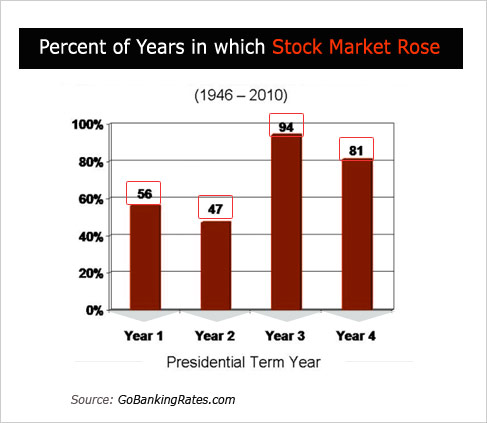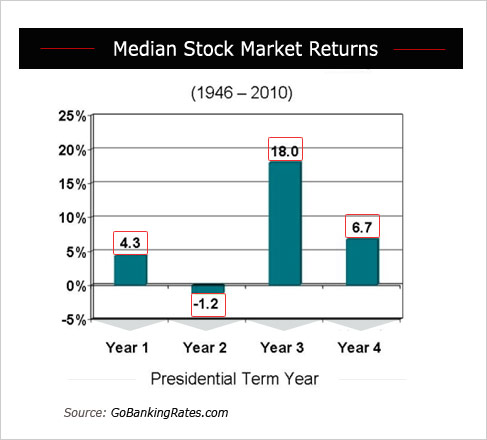Investors are looking ahead for 2012, but many of them will be hoping history repeats itself. They’re not placing bets on a repeat of 2011, but on U.S. presidential history.
Since the end of WWII, the second half of a president’s term and the period prior to a presidential election tend to coincide with economic growth and better business conditions. “Election years have traditionally been kind to the stock market because the administration’s agenda is heavily focused on growing the economy to gain voter support,” says Michael Carrazza, chairman and chief executive officer of Solaia Capital Advisers in Stamford, Conn. Presidents are “very careful to avoid sweeping policies that could either harm business growth or signal mounting economic stress.”
Related: 3 Plays That Can Boost Portfolios in 2012
A look at the median returns for each of the four years in presidential terms since the end of WWII:


Still, the historic trends don’t guarantee a calm year in the markets. In fact, financial experts remain wary of market volatility. Triple-digit swings in the market seem to be the new “norm,” they say. “Everyone has a crystal ball, it’s just a matter of how well it functions,” says Frank Armstrong, Investor Solutions in Miami. “Who knew gold would have such a phenomenal runup in 2011? Nobody would have put odds on lower interest rates. [Last year] was a grubby, grubby year.”
Below are 10 important investment trends to consider when taking stock of your portfolio in 2012, according to financial experts:
- Unrest in the international community. The continued turmoil in the international sector, particularly Europe’s credit problem will continue to weigh on clients’ portfolios, says Eric Markowitz at Firstrust Financial Resources in Philadelphia, Penn. Foreign stocks make up as much as 30 percent of many growth portfolios. In order to minimize the volatility, investors should moderate exposure to that sector.
- Cautioned optimism for U.S. economy. Ongoing debate over fiscal policy in Washington tempers what could be a tremendous opportunity for U.S. markets, says Markowitz, as some parts of the economy show improvement. Investors willing to dive in may capitalize on this optimism.
- Stocks offer better opportunity than bonds in 2012. Although volatility is likely to continue, very reasonable valuation levels on stocks afford upside potential in 2012, says Jeff Layman, chief investment officer at BKD Wealth Advisors in Springfield, Missouri. But for bonds, with interest rates at extremely low levels (ex. 1.91 percent on a 10-year Treasury note), the total return potential from U.S. investment grade bonds is very limited, Layman says. Certain “satellite” bond segments, such as emerging markets debt and global high-yield bonds, offer better opportunity going forward.
- 4. Emerging market stocks and bonds offer great potential: After the decline in shares prices in 2011, EM stocks now trade at a multiple of less than 10 times earnings, with expected earnings growth that averages in the low teens, Layman points out. Meanwhile EM bonds offer yields of 7 percent, improving credit quality, and fiscal surpluses in many of the economies.
- Commodities should rebound as U.S. economic fears fade. Economic data from the past few months indicates that U.S. GDP growth has actually accelerated. “Low expectations create a better chance of positive surprise,” Layman says. “Improvement in the global economy would translate into gains in most commodities, in our opinion, reversing the negative returns of 2011.”
- Gas it up. Natural gas prices should begin to benefit from liquefied natural gas (LNG) exports and increasing sources of domestic demand, says Kent Croft, CIO and portfolio manager, Croft Value Fund. “We believe that exploration and production companies with large natural gas exposures will be prime beneficiaries of higher natural gas prices going forward,” he says.
- Robust growth for broadband internet. Broadband internet penetration growth has caused IP traffic to increase eight-fold over the past five years with continued robust growth expected, thanks to increased use of mobile devices and bandwidth-intensive streaming video, says Croft. “We believe the key beneficiaries are companies who provide better service and enrich the online experience via their software, hardware, and applications,” he says.
- Timber is a solid investment. Despite a continued weak domestic housing market, Croft views timber as a solid investment on strong foreign demand prospects and an eventual bottom in the U.S. market. Timber stocks are attractively priced and typically offer solid dividend yields.
- U.S. companies are growing stronger. Corporate profits are at an all-time high. Companies are sitting on mountains of cash – more than $2 trillion among the S&P 500 companies alone. While companies are reluctant to hire, they are deploying capital in other ways: initiating and increasing dividends, buying back stock, building infrastructure and making acquisitions, according to Neil Hennessy, CIO and portfolio manager and Brian Perry, co-portfolio manager, Hennessy Funds in Novato, Calif.
- Flight to safety and guaranteed products. Emerging retirees without traditional pensions will allocate a portion of their nest eggs to vehicles with guaranteed minimum income streams (for example, properly selected annuities) to help reduce the overall risk of a portfolio, and to provide steady retirement income, Markowitz says. Many investors will likely go back to basics, finding practical investments such as utilities attractive.

